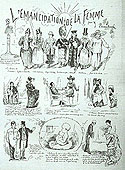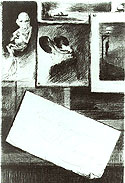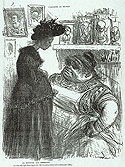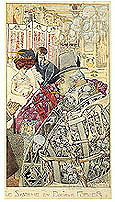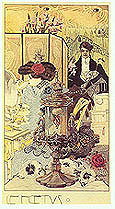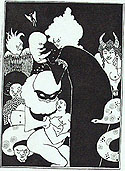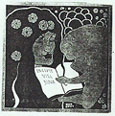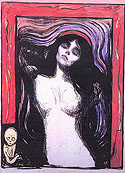The browser will either open the file, download it, or display a dialog.
|
|
Anatomy of a Motif: The Fetus in Late 19th-Century Graphic Art |
||||||||||
|
Images of fetuses, bottled or dried and frequently deformed, first appeared in French graphic art around the middle of the nineteenth century and became more prevalent during the fin-de-siècle, when the motif was found in the work of Henry Somm (1844-1907), Charles Léandre (1862-1930) and Gustav-Adolphe Mossa (1883-1971). In the 1890s, artists visiting Paris from abroad, notably Aubrey Beardsley (1872-1898) and Edvard Munch (1863-1944), also became interested in the fetus and began to represent it in their art. Though the fetus motif never became widespread, its occurrence in the graphic art of several late-nineteenth-century artists, most of them belonging to the Symbolist movement, nonetheless raises many questions. What was its significance for nineteenth-century viewers? How was it related to the social and political issues of the day—issues such as abortion and closely related fears of depopulation, racial degeneration, and deformity, as well the lightning rod for such fears—feminism. What personal investment did the artists in question have in the motif? And how and in what contexts did it appear in their art? | ||||||||||
| This essay is an attempt to answer these questions. In it, I will show that the success of the fetus as a motif in Symbolist art was due to its multivalence. Because it was new and untried, (and shocking to boot), its meaning had not been fixed. To the symbolists it was a flexible signifier that allowed them to invest the motif with a variety of meanings. This article will describe the temporal socio-political context in which the motif appeared—most notably the fear of depopulation, degeneration, and deformity. It then will present a number of specific examples of the motif in late nineteenth-century graphic art to demonstrate the ways in which it was used for a variety of expressive purposes. | |||||||||||
|
Scientific Models for the Fetus Motif Aborted fetuses stored in glass flasks were used as early as the sixteenth century as specimens to study the developmental stages of human beings. Pierre Robin, an obstetrician from Reims, reported in his catalogue of anatomical specimens (ca. 1800) that he had ten fetal skeletons, as well as "embryos, fetuses, and products of miscarriages" which served him as "visual aids" in his training of midwives.1 Collections in France's capital city provided accessible models for representations of the bottled or otherwise preserved fetuses that appeared in graphic art during the nineteenth century. The École de Médecine displayed bottled specimens in different stages of growth as part of extensive exhibits on gestational development within the womb (figs. 1-2).2 In 1833 the collection of Geoffroy de Saint-Hilaire, part of the Natural History Museum in Paris, contained forty-three, probably dried, fetal specimens, all of which came from ancient Breton and Gallic graves. Bottled fetuses, (still part of the Natural History Museum's collection today) were added in the nineteenth century.3 The galleries of comparative anatomy, zoology, botany, and geology, where this material was housed, were open to the public. An 1884 issue of La Nature demonstrated the continued popularity of specimens in the museum.4 Traveling sideshows, which obtained their examples from various sources, apparently both legal and illegal, reinforced this popularity by presenting fetuses for public entertainment.5 |
||||||||||
| The Fetus and its Associations with Depopulation and Degeneration During the late nineteenth century, the sight of a bottled fetus, the product of an unsuccessful or unwanted pregnancy, must have struck many people as a fitting symbol of depopulation, which had become a pressing social issue for France as the country tried to regain its position of power in the face of the increasing strength of a well-populated Germany. The disastrous defeat of France in the Franco-Prussian war of 1870 and the stresses of the Commune that followed had resulted in a population decrease, which caused a nationwide concern.6 The magnitude of this concern is suggested by the more than two hundred works listed in Victor Turquan's 1902 Contribution à l'étude de la population et de la dépopulation.7 An illustration by the artist Draner [pseud. of Jules Renard] for Le Charivari depicts various members of society stating their reasons for not having children. The women cited primarily personal reasons. A feminist says, "I want to remain a woman and not become a female"8; another woman fears her child would not resemble her husband; a third claims that being pregnant would interfere with her sex life; and yet another says she would be obliged to reduce her clothing and jewelry budget. The men blamed the women in their lives—or the lack of any.9 Emile Zola expressed the dire need for new births in an article entitled "Aux mères heureuses" (To the happy mothers] for Le Figaro: "It means the reduction of mortality, they [the newborn babies] are small saved Frenchmen, at a time when depopulation of the country frightens us all."10 |
|||||||||||
|
The most commonly cited cause of depopulation was the contemporary feminist movement. In an illustration for Paris s'amuse entitled "L'Emancipation de la femme,"11 women are shown taking on masculine roles, which leads in turn to men performing feminine tasks. At the bottom is an infant (fig. 3), which has been left to take care of itself because its mother is too absorbed in politics. The child has been given a bottle of wine to suckle. In the background is a fetus in a bottle. The image suggests that feminism leads to abandoned children, or worse—as fetuses are prematurely aborted—to no children at all. | ||||||||||
| The nineteenth-century economist Paul Leroy-Beaulieu provided statistical corroboration for the claim that feminism was to blame for the decline in the birth rate.12 G. Vacher de Lapouge also blamed feminism for the intellectual degeneration of the population. As feminism presumably was a movement that attracted more intelligent, upper-class women, he suggested that feminists that chose not to have children were turning back the evolutionary clock.13 This theory was a modification of the "hereditary degeneration" theory of Benedict Morel, which was complicated by Vacher through the introduction of class issues.14 Indeed, as important as the problem of depopulation was to France as a whole, it was especially crucial to the upper-middle class; as to them the decrease in the birthrate threatened both their political and social status quo.15 | |||||||||||
| Politicians as well as church leaders blamed the feminist movement for the decline in population and successfully promoted its "guilt" in the popular press. Newspapers and magazines promoted the idea that the emancipation movement was destroying the family. The Courrier de France noted: "Wives and mothers, no more baby clothes; just a flag. No more pots-au-feu; just the ballot box: Woman, the voter and soldier."16 Rarely did feminists respond to statements or visual images in the popular press, perhaps because they recognized that their objections would give the creators of the inflammatory material more ammunition against them. | |||||||||||
| It is true that feminists like Marie Huot, Marguerite Durand, and Gabrielle Petit provided fodder for their critics by actively discussing the necessity of limiting family size. From their perspective, the "restriction of fertility represented a form of 'revolt' against the dictates of nature and the dominance of men."17 In a public lecture, Maria Deraismes dismissed the popular notions that it was "love of luxury" and the desire to lavish attention on one or two infants that caused the current state of affairs.18 Both Deraismes and Maria Martin, publisher of the Journal des femmes, believed that better care of children after their birth—especially those born out of wedlock—would be the most effective method of solving the serious problem of depopulation.19 Yet, though they advocated family planning, the feminists rejected contraception or abortion, as they considered both these practices to be in the realm of prostitution. Anti-feminist purveyors of popular culture, however, ignored the complexities of the feminists' position regarding methods of restricting family size and tended to conflate the various options available (abstinence, contraception and abortion) as agents of depopulation. | |||||||||||
| Angus McLaren, in his 1983 book, Sexuality and Social Order, cites statistical evidence suggesting that the drop in birthrate was due to two factors: fewer children born in each marriage and an increase in proportion of unmarried women. The perception within the contemporary medical community, however, was that infanticide and abortion were being practiced at an alarming rate. McLaren shows that a shift occurred in the type of woman likely to seek an abortion—from the "seduced girl" early in the nineteenth century to, after 1880, the "married woman seeking to control the size of her family."20 This latter demographic group was of particular interest to both the church and politicians; it is therefore not surprising that an actual or perceived increase in abortions by married women would be perceived as a threat. According to McLaren, French doctors, "angered by an emerging feminism," were ready to blame the increased abortions among married women not on "a decision made by husband and wife—but on the selfish act of the independent woman."21 | |||||||||||
|
Fetuses and Monstrosity While bottled fetuses, to some nineteenth-century viewers, may have seemed fitting symbols of depopulation, to others they were associated with abnormalities, deformity, and even monstrosity. A monster was a creature with a perceived physiological abnormality. The sixteenth-century physician to the kings of France, Ambroise Paré (1510-1590), described monsters as "things that appear outside the course of Nature (and are usually signs of some forthcoming misfortune)."22 According to Paré, there were thirteen primary causes of monsters, including, too small a womb, bad posture, and the imagination of the mother. In the seventeenth century, it was believed that the thoughts of the mother during intercourse or pregnancy could imprint upon the fetus whatever was imagined—no matter how innocuous or bizarre.23 The placing of blame for abnormalities on women continued during the Enlightenment, when the respected scientist Jean Palfyn (1650-1730) determined the female organs to be "the source of errors."24 Though by the early nineteenth century the beliefs of the "imaginationists" began to be contested within the scientific community, they continued to be held by the general public.25 The fact that traces of the theories appear in Villiers de l'Isle-Adam's story Claire Lenoir (1867) confirms as much,26 and so does a vignette in Frédéric Soulié's Physiologie du bas-bleu of ca. 1842 (fig. 4). The vignette accompanies the tale of an experiment in procreation between a very intelligent man and a gracious, coquettish bluestocking or bas-bleu.27 The two discuss the child's conception over dinner, in terms of mathematical theorems. Every truffle and each glass of champagne consumed by the couple is accompanied by a new algebraic equation. When their brains and senses are properly stimulated, they proceed to "l'oeuvre de Dieu." Nine months later an infant is born, but instead of the predicted exceptional child, it is a cretin.28 The moral of the story is that a bas-bleu's intelligence produces not a better human being, but a degenerate one. Women, during conception, must focus on motherhood and not on science or mathematics. The vignette shows the deformed offspring as a medical specimen in a jar to demonstrate how far it is from a real child in a real family.29 |
||||||||||
| The nineteenth-century public, still under the influence of the imaginationists, held women responsible for birth defects. But men were blamed for infertility and stillbirths because of a persistent belief that, immediately after conception, the "male" element formed the embryo's vital ectoderm or outer membrane, in which the nervous system and circulation were located.30 Most likely to produce a stillborn infant was the male who had been "feminized" in some way. Paul Bourget, in his Physiologie de l'amour moderne (1891) cited the pace of modern life as well as sexual exhaustion caused by the frequenting of prostitutes as the origin of feminization of the male, which, he argued, could compromise the ability to sire healthy children.31 | |||||||||||
| As a result of these divergent beliefs, the mother could be (and was) blamed for a deformed fetus on the basis of imaginist philosophy and blamed for the aborting of fetuses that could have gone full term; even a man's weaknesses with respect to conception were blamed on women—the prostitutes they frequented. Indeed, no matter what form the argument about conception took, the blame for whatever went wrong with it was placed on women.32 They were responsible for the declining birthrate in France as well as for the degeneration of its population; they were also blamed for giving birth to cretins and monsters and, indirectly, for male impotence and stillbirths. By extension, women, particularly of childbearing age, came to be associated with a sense of decadence and decay, which itself came to be represented metaphorically in the aborted fetus. | |||||||||||
| The Fetus in Late-Nineteenth-Century French Graphic Art The appearance of the fetus in the popular imagination of the late nineteenth century did not go unnoticed by contemporary artists. The Symbolists, especially, were quick to adopt the motif into their works. While in popular graphic art the fetus had been in the first instance a visual weapon against feminism, in the prints of the Symbolists the motif took on more complex meanings, often related to artists' negative view of themselves and the world around them. |
|||||||||||
| The fetus is especially prominent in the works of several printmakers in France during the last two decades of the nineteenth century. One of these artists, François-Clément Sommier, known as Henry Somm (1844-1907), was a minor Impressionist painter, illustrator, and printmaker, whose graphic work often has important Symbolist overtones. Somm was a founding member of the "Ancien Chat Noir" society and, most likely, a member of a secret misogynist subgroup of that society.33 His art focused primarily on the woman of Paris—her virtues and vices, her innocence and her perversity. The writer and critic Léon Roger-Milès (1859-1928) speculated that Somm's drawings were his way of releasing what he kept hidden—sites where he could cleanse his conscience.34 Unfortunately Roger-Milès was vague about what issues Somm needed to resolve with his conscience. His article promoted the artist's work by creating a sense of mystery more than it did to clarify specific creative motives. A poem copied by Somm on the edge of a sheet of drawings may explain the frequently macabre subtext in his works. In it he equates his preferred medium—etching—with "bloody homicides," "rapes," "incest" and "evil" and he commands these themes to "come forth" as if intoning an incantation to summon up a spirit.35 | |||||||||||
|
A print of 1880 or 1881 (fig. 5) shows a wall in a studio (perhaps Somm's own) covered with prints. The subjects of the prints include a monstrous fetus with webbed feet, a landscape with a boat, a fashionable woman with a large hat, and a man hanging from a gallows. The web-footed fetus seems to be informed by existing medical specimens called sirènes or "sirens" after the mythological figures that lured unsuspecting sailors to their deaths. As this print contains a space resembling a calling card, it is tempting to speculate that the print as a whole was intended to represent Somm's oeuvre as it relates to the femme fatale. The fashionable Parisienne has seemingly caused the death of the man who loves her and the deformation of their offspring. Unfortunately, nothing is known about Somm's family history; whatever the print may suggest about Somm's relation to his parents can only remain a guess. | ||||||||||
|
That Somm indeed identified with the fetus figure is borne out by a watercolor in which he has drawn his own self-portrait in the form of a fetus in a jar (fig. 6). The drawing seems to express the artist's feeling of being bottled up and shelved like a fetus. As specimens at that time were preserved in alcohol, the drawing also may be related to Somm's alcoholism. Several newspaper illustrations by Somm, in which full-grown men are shown in liquor bottles, such as in his Psychologues for Le Rire, confirm this view.36 Maurice Mac-Nab, a well-known Montmartre performer, included in his repertoire "Les foetus," a poem that describes the "lives" of specimens preserved in alcohol—they spend all of their time drinking—as "privés d'amour," and he chronicled in rhyme their various deformities.37 Mac-Nab, like Somm, was both a member of the Hydropathes and the Ancien Chat Noir in Montmartre.38 | ||||||||||
|
What ties Somm's fetus images together is the fear of degeneration, the physical, mental, and moral decline of the human race. Degeneration might be the result of the birth process and heredity or of outside agents, such as alcoholism and, more generally, decadence and the degradation of the social fabric. The linkage of the fetus with degeneration is made visible in a series of illustrations called "Les Monstres de la société," which Charles Léandre drew for the satirical paper L'Assiette au beurre.39 The introduction to the series, which appeared in 1902, linked it directly to contemporary theories of degeneration:
Léandre's "monsters" are primarily members of the bourgeoisie—many of them known individuals, carefully caricatured—who had repeatedly engaged in illicit sexual affairs. Also caricatured in the series are members of the government, "snobs," journalists, and bas-bleus; the latter group described as asexual and ageless. But the greatest monster of them all, the "The Monster of Monsters," is a grotesquely rotund abortionist, female but with masculine facial characteristics, who greets a new client clearly in an advanced stage of pregnancy (fig. 7). Rows of bell jars in the background indicate the impending outcome of the visit. The caption reveals that both women partake in the dual roles of creator and destroyer: "Here we make angels. We compete with the Church."41 |
||||||||||
|
|
|||||||||||
| Several of the illustrations in Léandre's series allude to theories of evolution by combining human with animal physiognomies. In "Man. King of the Animals in his Principal Transformations," Léandre shows a metamorphosis in four stages, beginning with a fish with human facial characteristics and progressing through a snake and a man to arrive at a pig wearing a bourgeois top hat. The illustration entitled "Paris" features Mercury and Paris perched atop a dog-like beast. The mythological couple is so self-absorbed that they are unaware that the beast busily shoves hoards of citizens into its cavernous mouth in an apocalyptic scene consistent with contemporary predications of the end result of degeneration. | |||||||||||
|
Five years after Léandre, another artist used the fetus motif to express fears of decadence and degeneration. In 1907, Gustav Adolph Mossa treated the theme of the abortionist and the bottled baby in a pair of watercolors. In the first, Dr. Forceps dressed in a skull-patterned coat, visits a woman in her bedroom (fig. 8). The Doctor's hands, which today might bring to mind the mechanical claws of Edward Scissorhands in the popular movie of the 1990s, are mechanical. They instill a sense of fear in the viewer, as they are suggestive of the instrument used in the operation. Bright red, they provide the focal point of the image while reinforcing the intended use of the forceps that will soon be covered with the blood of the unborn. Mossa has created a most evil figure. His Dr. Forceps is bloated, smokes a large cigar, and reveals, through his dress, that he has capitalized on the numerous abortions for which he has been well paid. The woman's spouse, seen in the background, appears complicit in the action, as he is the one who will pay Dr. Forceps. A host of floating ghost-like fetuses announces the result of the doctor's visit. The second work, The Foetus (fig. 9) continues the story of the same couple after the abortion. The elaborately dressed woman is powdering her face while admiring herself in the mirror. The man appears in the back of the room next to a stack of boxes—obviously recent purchases. Poppies, symbols of death, are strewn around the base of an elaborate container for the fetus, which is placed on a table as if it were some type of holy relic. The clear glass allows the woman's costume to be seen in conjunction with the unborn child, suggesting a parallel between her and the container as a vessel of death. Mossa equates the frivolity of high society with spiritual and physical decay by showing a young wealthy couple unwilling to have anything stand in their way of material gain—certainly not children. | ||||||||||
| The use of the fetal motif by the British artist Aubrey Beardsley and the Norwegian Edvard Munch seem closely related to its appearance in French art. In Beardsley's work, the fetus, or embryo, as Beardsley scholars prefer to describe it, first appears in his work in 1892-93, following a trip to Paris. It is possible that he saw the motif in Somm's work, but it is more likely that he saw a display of medical specimens, either at the École de Médecine or in a traveling sideshow.42 While similar shows, called "Monster-mongers and other Retailers of strange sights"43 by Jonathan Swift, had been popular in London in the seventeenth and eighteenth centuries, they were banned in the nineteenth, making it likely that Beardsley became interested in the motif during his trip to Paris. Beardsley's use of the fetus motif coincides with his disparagement by London critics for being infected by the "French germ" of decadent art, as well as with his growing reputation in France, especially in Symbolist circles.44 | |||||||||||
|
Milly Heyd has related Beardsley's use of the embryo to the artist's interest in "primordial states" and the subject of creation, and she has compared his works featuring embryos with earlier works by such artists as Otto Runge, William Blake, and Odilon Redon. According to Heyd, Beardsley used the fetus in a manner similar to Redon's, revealing a "subjective and personal approach" in which "the embryo as symbol of Beardsley himself is witness to the essential narcissistic modernism of his work."45 Other scholars have speculated that the fetus motif emerged from Beardsley's illness (which may have prompted his study of scientific texts), or to his having witnessed a miscarriage first-hand.46 Beardsley first used the motif in several of the "grotesques" he provided as book illustrations for The Bon Mots of Sydney Smith and R. Brinsley Sheridan. He described how he worked on them in the fall of 1892, following his trip to Paris in June of that year.47 A vignette of a woman receiving a fetus from an alchemist (or abortionist) (fig. 10) appears early in the text, near a paragraph calling for an "expression of hostility to the Church establishment."48 The skull of the embryo is divided into zones suggestive of adult cranial development and the hands and feet are misshapen. The accompanying text describes a Mrs. Marcet visiting Sydney Smith, who introduces himself as a doctor and describes his medicines:
Mrs. Marcet is then taken into a room stocked on one side with medicines and on the other with meat—"a beef, veal, mutton, pork, lamb, venison show!"50 In this illustration, Beardsley seems to comment on the practice of abortion and the treatment of prospective human life. Linda Zatlin has argued convincingly that the fetus in Beardsley's work expresses "a woman's ambivalence towards pregnancy and motherhood's difficulties."51 |
||||||||||
| Beardsley also used the embryo motif in a series of illustrations for an edition of Lucian's True History (1894), on which he began to work in 1892. Dreams shows a perverted Christian adoration scene, in which an embryo is held up to a group of grotesque females—frightening femmes fatales à la Salome and Medusa—whose creed appears to be centered on sex without motherhood. The femme fatale idea is most fully developed in another illustration that fell victim to the censors; Lucian's Strange Creatures (fig. 11), in which a fetus is held by what appears to be a priestess who is surrounded by a large snake and various strange beings.52 | |||||||||||
| An alternative use of the fetus motif involved its connection with the traditional ideal of virtuous motherhood, the Virgin Mary or Madonna. In Beardsley's Incipit Vita Nova (1893; fig. 12), a seated fetus is placed opposite the flower-bedecked head of a woman. Between them is an open book in which are written the words, "INCIPIT VITA NOVA," or, "new life begins." Beardsley's pairing of this phrase with the motif he had developed as a reference to abortion contains a certain amount of irony. The implication that the Christ child, as product of a "virgin birth," is simultaneously an unwanted pregnancy puts a bizarre twist on traditional "Madonna and Child" images. | |||||||||||
| Another non-French artist who manipulated this familiar iconography to address sexuality, religion and reproduction was Edvard Munch, most notably in his well-known group of paintings and prints entitled Madonna (1894-1896). Norwegian by birth, Munch studied in Paris between 1889 and 1891 in the atelier of Léon Bonnat, an academic artist who made full use of anatomical models.53 His exposure to bottled fetuses at the Natural History Museum, the École de Médecine, or a sideshow, seems likely, especially since his oil painting of the Madonna (1893-94; Oslo, Munch Museet) was completed immediately following a stay in Paris, and a hand-colored lithograph (fig. 13) based on that painting was destined for an exhibition there.54 His model for the fetus in this lithograph may have been a mummified specimen, such as one still on display at the École de Médecine (fig. 14).55 Scholars cite numerous debilitating personal relationships that influenced Munch's depictions of women (including the death of his sister and mother, and a number of tragic love affairs). But his decision to modify his already shocking oil painting of a sensuously-writhing nude Madonna through the addition of sperm and a fetus during its translation into a print, seems in retrospect to be a calculated move to curry favor with French Symbolists. | |||||||||||
| The Swedish writer Arthur Strindberg, who saw Munch's above-mentioned print (fig. 13), at Siegfried Bing's Maison de l'Art Nouveau in Paris, stated "Immaculate or not, it's all the same. The red or gold halo that crowns the consummation of the act, the only justification for this creature's life—with no existence of its own."56 Strindberg was of the belief that sexual decadence was a characteristic of the New Woman, and doubtlessly knew of early sex studies such as those by Otto Weininger, Havelock Ellis, Max Nordau, and others—the very same studies that Munch and his compatriots in Berlin read and debated.57 Munch's explanation of the Madonna blended life with inevitable death: "It is the smile of a corpse. Now life reaches out a hand to death...The chain that links thousands of generations that have gone before with thousands of generations to come. Life is born only to be born again, and die."58 Arne Eggum has suggested that, for Munch, "pregnancy means death."59 | |||||||||||
| Munch would use the fetus motif again, in his 1896 painting Madonna in a Graveyard (Oslo, Munch Museet). In this work, the Madonna appears haggard rather than orgasmic and the fetus exists in skeletal form and holds two arrows and a broken bow in a macabre imitation of Cupid. The straightforward interpretation is that "love implies death or love may be coupled with death."60 In Munch's 1898 Inheritance a sickly fetus squirms on a woman's lap, a "syphilitic recapitulation of the Madonna and child theme."61 The death of an infant (either by accident, disease, or by a deliberate act of abortion) represented a death of a part of the father's "self"—and it was in this sense that Munch interwove his personal feelings into these Symbolist works matching, and enlarging, very similar views and beliefs held by several Symbolist artists, including those discussed above, in the ways in which they used the fetus to enlarge on their own beliefs and feelings. | |||||||||||
| Conclusion The bottled fetus, common in late nineteenth-century graphic art, is a signifier of a complex set of intersecting ideas concerning depopulation, feminism, physical degeneration, and social and moral decadence. The image communicates male fear, and hatred of the "new woman," whether the stereotypically mannish feminist, the femme fatale, or the superficial consumer of luxury items. Fashionable women shown visiting the abortionist or contemplating a deformed fetus suggest the forfeit of procreation and family to intellectual or materialist pursuits. Monstrous fetuses may suggest the women's lack of interest in maternity, as well as, more generally, the fear of degeneration as a result of both hereditary and environmental factors. |
|||||||||||
| The multivalence of the motif made it attractive to Symbolist artists, who used it for the expression of their own private thoughts. Representing himself as a fetus in a jar, Henry Somm referred to his addiction to alcohol, which made him a prisoner of the bottle. In other works Somm suggested the malformed fetus was a product of the femme fatale (itself an anti-feminist response to the New Woman).62 In Beardsley's work, the fetus, surrounded by frightening creatures, could express his fear of women who did not accept the domestic ideal of motherhood. For these artists the fetus was a motif that allowed them to comment on the evil and decay that, they found, pervaded society and infected their own daily existence. The motif was the more powerful as the fetus traditionally was associated with new life. Thus, it became doubly threatening when it was perverted through references to material excesses, decadent society and the feminist movement. | |||||||||||
|
Note: All translations are the author's own unless otherwise indicated. 1. Jacques Gélis,, trans. Rosemary Morris, (Cambridge: Polity Press, 1991), p. 219. 2. Today this collection exists as part of the Musée Dupuytren. The author wishes to thank Paul Prudhomme de Saint-Maur, Professeur d'Anatomie Pathologique à l'U.F.R. Saint-Antoine and Conservateur du Musée Dupuytren, for the information he shared with the author that clarified the history of the collection of the École de Médecine, which opened in the 1830s and existed without change until it closed in 1937. In 1967 it was re-opened in its current location as the Musée Dupuytren. Because the catalogue of the collection is incomplete, it is not possible to document when the "malformations" entered the collection. However, M. Prudhomme de Saint-Maur believes that they entered the collection before the end of the nineteenth century. Unlike the Natural History Museum at the Jardin des Plantes, the École de Médecine did not keep a register of visitors, but visitation by artists and the general public was possible, even through bribery of the museum's employees. M. Prudhomme de Saint-Maur also confirms that the collection was known to the public at large and that it "suscitait bien des fantasmes" (e-mail dated 8 November, 2000). Other facts which would have enticed the public included the original installation of the collection in a Gothic convent refectory and the immersion of the specimens in a "secret sauce." Paul P. de Saint-Maur, "Le Musée Dupuytren et le Musée Dejerine" in Les Musées de Médecine, (Paris: Privat, 1999), non-paginated copy provided by the author. 3. Achille Valenciennes, "Catalogues des préparations anatomiques laissées dans le cabinet d'anatomie comparée du Museum d'Histoire Naturelle, par G. Cuvier," Nouvelles Annales du Muséum d'Histoire naturelle 2 (1833), p. 429. The author wishes to express her thanks to Cédric Crémière, who was kind enough to discuss the collection of the Muséum national d'Histoire naturelle and provided photographs and a copy of a portion of his thesis, "Mettre en scène l'esprit scientifique: La Galerie d'anatomie comparée," Mémoire de DEA, Muséologie, Muséum national d'Histoire naturelle, 1998. 4. See Bruno Béguet, ed., La science pour tous: Sur la vulgarisation scientifique en France de 1850 à 1914. (Paris: Bibliothèque du Conservatoire national des arts et métiers, 1990), pp.136-138. In 1874 the attendance numbers for the Jardin approached 600,000—numbers are not available for the specific galleries in the Museum. Statistics from 1861 to 1874 are summarized in Michael Osborne, "The Société zoologique d'acclimatation and the New French Empire: The Science and Political Economy of Economic Zoology during the Second Empire," (Ph.D. Diss. University of Wisconsin-Madison, 1987), p. 182. A register conserved at the Archives Nationales (AJ15*145) lists a number of artists, including Camille Claudel and Henri Matisse, who received permission to study in the collection between 1832 and 1896 (Visiteurs et étudiants du cabinet d'anatomie 1832-1896). 5. This information was provided by Paul Prudhomme de Saint-Maur, see footnote 2, above. 6. For a summary of the statistical evidence of depopulation and the attempts to reverse the trend see "La chute de la fécondité," in Histoire de la population française (Paris: Presses Universitaires de France, 1988), vol. 3, chap. 7, pp. 351-402. For an interpretation of that evidence as it relates to the perceived "health of the nation" see Robert Nye, "Population, Degeneration and Reproduction," in Masculinity and Male Codes of Honor in Modern France (Oxford: Oxford University Press, 1993), chap. 5. 7. Victor Turquan. Contribution à l'étude de la population et de la dépopulation (Paris, 1902). 8. "Je veux rester femme et non devenir femelle" 9. Draner, "Enquête charivarique sur la dépopulation," Le Charivari, 11 January 1900, p. 5. 10. "C'est la mortalité réduite, ce sont des petits Français sauvés, à l'heure où la dépopulation du pays nous épouvante tous." Emile Zola "Aux mères heureuses" Le Figaro, 18 April 1891, p. 1. See also, Emile Zola, "Dépopulation," Le Figaro, 23 May 1896, p. 1, and Blowitz, "Contre la dépopulation," Le Figaro, 28 July 1897, p. 1. 11. Jean Beauduin, "L'émancipation de la femme," Paris s'amuse, 27 January 1883, p. 200. 12. Paul Leroy-Beaulieu, La question de la population. (Paris: F. Alcan, 1913). 13. Angus McLaren, Sexuality and Social Order. (London: Holmes & Meier, 1983), p. 154. See also Karen Offen, "Depopulation, Nationalism and Feminism in Fin-de-Siècle France," American Historical Review 89 (1984), pp. 648-676. 14. Dr. Benedict A. Morel, Traité des dégénérescences physiques, intellectuelles et morales de l'espèce humaine (Paris, 1857). Morel counted among his credentials being Médecin en chef de l'Asile de Saint-Yon, Ancien médecin en chef de l'Asile de Maréville and Lauréat de l'Institut (Académie des sciences). 15. Rosalind Petchesky, Abortion and Woman's Choice: The State, Sexuality, and Reproductive Freedom (Boston: Northeastern University Press, c.1990), p. 39. 16. Translated and reprinted in Claire Goldberg Moses,. (NY: SUNY, 1984) p. 195. 17. McLaren, p. 163. 18. A summary of Maria Deraismes' lecture on the subject is contained in Maria Martin, "Dépopulation," Journal des femmes, no. 14 (January, 1893), pp. 1-2. (Deraismes' "Dépopulation" was included in her text Les droits de l'enfant in 1887—see also her article "La régénération de la France," L'avenir des Femmes, 5 November 1871, pp. 1-2). 19. Maria Martin, "Dépopulation," Journal des femmes, no. 9 (August, 1892), p. 1. The most comprehensive article to appear in the journal on the subject was Camille Bélilon and Hyacinthe Bélilon, "Rapport sur qualité prime quantité," Journal des femmes, two-page supplement to December, 1903. On the statistics of illegitimate children and social implications see Catherine Rollet-Echalier, (Institut National d'Études Démographiques, Presses Universitaires de France, 1990), especially chap. 2. 20. McLaren, p. 140. 21. Ibid., p. 148. 22. Ambroise Paré, On Monsters and Marvels, trans. Janis Pallister, (Chicago: University of Chicago Press, 1982), p. xv. The earliest version of the treatise Des monstres et prodiges appeared in 1573. 23. Marie-Hélène Huet, Monstrous Imagination (Cambridge, MA: Harvard University Press, 1993), p. 17. 24. Ibid., p. 57. 25. On the progression of medical theories of monstrosity, see Jean Borie, Mythologies de l'hérédité au XIXe siècle (Paris: Éditions Galilée, 1981), especially pp. 83-100. 26. "Have you given any thought to these human monstrosities [...] horrible errors of nature, all issued from a sensation, a whim, a sight, an IDEA that occurred during the mother's pregnancy?" (quoted in Huet, p. 103). 27. Frédéric Soulié, Physiologie du bas-bleu. Vignettes by Jules Vernier (Paris: n.d.). The Bibliothèque nationale has given this text an approximate date of 1800, but the proliferation of studies of this type during the July Monarchy makes the 1840s a better approximation. 28. Soulié, p. 31. 29. The bell jar was commonly in use for the preservation of medical specimens—a practice apparently initiated by the Dutch, who imported them to other countries, including Japan. See Timothy Benjamin Mark Screech, The Western Scientific Gaze and Popular Culture in late Edo, Japan, (Ph.D. Diss., Harvard University, 1991), especially pp. 206-214. 30. Nye, Masculinity and Male Codes of Honor, p. 86. 31. Paul Bourget, Physiologie de l'amour moderne (Paris: A. Lamerre, 1891). 32. On the subject of artists' interest in evolution in terms of nature vs. nurture and women's culpability see Barbara Larson, "La génération symboliste et la révolution darwinienne" in L'âme au corps. Arts et sciences 1793-1993 (Réunion des musées nationaux, Gallimard/Electa, 1993), pp. 322-341 33. The very nature of this subgroup of the society makes proving its existence difficult. The primary source suggesting its existence is a document titled "Le Livre d'Or du Chat Noir" kept at the Bibliothèque Historique de la Ville de Paris. The title was seemingly provided by the library and the work remains uncatalogued, although it was displayed during an exhibition on the history of Montmartre. The document appears to be a register or autograph book in which the members of the "ancient" society of the Chat Noir wrote poetry and provided illustrations. It is the nature of the illustrations themselves and the content of the poetry and prose, which suggest the underground and misogynistic nature of the subgroup of the society. 34. L. Roger-Miles, "Henry Somm," Les Hommes d'aujourd'hui, no. 407, 1890s, p. 2. 35. Noirs desseins qui roulez en des âmes perverses / Homicides sanglantes perpétrés dans la nuit / Viols, incestes, eaux fortes, du mal sombres averses / Accourez!.... [Black schemes that ramble through perverse souls / Bloody homicides committed in the night/ Rapes, incest, etchings, evil dark downpour come forth!] (Bibliothèque Nationale, Cabinet des Estampes), Translation by Yvonne M.L. Weisberg. 36. 8 August 1903, p. 15. 37. Mac-Nab, "Les Foetus," originally published in Poèmes mobiles, reprinted in Bertrand Millanvoye, Anthologie des poètes de Montmartre. (Paris: Société d'éditions littèraires et artistiques, n.d. ), pp. 241-243. 38. On this group, see Raymon de Casteras and Maurice Dinnay: Avant le Chat Noir, les Hydropathes (Paris: A. Messein, 1945) and Jules Lévy, Les Hydropathes (Paris: Delpeuch, 1928). 39. The Issue for 4 October 1902, consisted only of Léandre's series of images. Léandre was a student of Alexandre Cabanel, a well-published caricaturist and co-founder of the Société des Humoristes. His work appeared in the journal Le Chat Noir, Le Figaro, Le Journal amusant and Le Rire, among others. 40. Vous croyez peut-être, bonnes gens, que Barnum a emporté avec lui tous les phénomènes vivants dont s'amuse l'attention publique. Bonnes gens, vous avez mal regardé: les monstres sont toujours là, grouillant du haut en bas de l'échelle sociale, étalant leurs difformités physiques ou morales; les monstres, ce sont les détraqués, les neurasthéniques, les avariés, que nous coudoyons dans nos maisons, dans la rue, sur les places publiques, monstres difformes, répugnants, dont les tares hideuses révélent un état social putride. 41. "Ici l'on fabrique des anges. On fait la concurrence à la maison Bon Dieu." 42. Linda Zatlin has drawn connections between Beardsley's use of the fetus motif and elements of the grotesque found in Japanese prints, as well as phrenological studies. Significantly Zatlin has reported that museums featuring medical anomolies were closed in and around London. See her Beardsley, Japonisme and thePerversion of the Victoran Ideal (Cambridge: Cambridge University Press, 1997), especially pp. 209-216 and "Aubrey Beardsley's 'Japanese' Grotesques," Victorian Literature and Culture vol. 25, no. 1 (1997), pp. 87-107. 43. Swift, A Tale of a Tub, 1704, reprinted in Richard D. Altick, The Shows of London (Harvard University Press, 1978), p. 34. 44. Jane Haville Desmarais, The Beardsley Industry: The Critical Reception in England and France, 1893-1914. (London Ashgate, 1998), especially chapter 6, "Beardsley and the Symbolists," pp. 104-116. Desmarais has compiled data relating to the availability of Beardsley's illustrated books (p. 109) and also compared the critical response in England and France side-by-side (Appendix 1). 45. Milly Heyd, Aubrey Beardsley: Symbol, Mask and Self-Irony. (New York/Berne: Peter Lang, 1986), p. 56. Heyd believes that the symbol in Beardsley's work is complex, and assigns to it a "trifold nature"—a symbol of the artist's life, a desire for procreation (termed "pregnancy envy" by Heyd) and the act of artistic creation. While these interpretations may indeed hold validity, I don't believe they represent the true scope of possibilities for the motif, which in Heyd's system is reduced to the scientific aspect of the motif at the expense of the possibilities inherent within the symbolist/decadent circles in which Beardsley involved himself. More disturbing is the sacrificing of the nature of texts in which the motif appears (in terms of content and meaning). 46. The arguments of Beardsley scholars Haldane MacFall, Brian Reade and MalcolmEaston are summarized by Heyd, pp. 56-58. 47. Aubrey Beardsley, Henry Maas, John Duncan and W. G. Good, The Letters of Aubrey Beardsley (Rutherford: Fairleigh Dickinson University Press, 1970), p. 34. 48. Sydney Smith, Richard Brinsley Sheridan, Walter Jerrold, Aubrey Beardsley and Joseph Pennell, Bon-mots of Sydney Smith and R. Brinsley Sheridan (London : J. M. Dent, 1893), p. 26. 49. Ibid., p. 88. 50. Ibid., p. 89. 51. Linda Zatlin, Aubrey Beardsley and Victorian Sexual Politics,(Oxford/New York: Clarendon Press/Oxford University Press, 1990), p. 113. 52. Aubrey Beardsley, Lucian's Strange Creatures (designed for Lucian's True History but unused), ca. 1893, illustrated in Zatlin, p. 33. 53. The relationship between Munch and French artists, especially the symbolists, is detailed in Munch et la France (Paris: Éditions de la Réunion des Musées nationaux, 1991). 54. At least one of the prints is signed "E. Munch 1896 Paris." See Robert Rosenblum, et. al, Edvard Munch. Symbols and Images (National Gallery of Art, Washington, DC, 1978), p. 217. On Munch's exhibitions in Paris and his relationship with Siegfried Bing's gallery L'Art Nouveau, see Arne Eggum, "Munch tente de conquérir Paris (1896-1900)", in Munch et la France, pp. 188-201. 55. An additional mummified specimen (originally thought to be that of a monkey) which an Italian archaeologist sold to Ètienne Geoffroy Saint-Hilaire, is illustrated in Jean-Louis Fischer, Monstres: Histoire du corps et de ses défauts. (Paris: Éditions Syros-Alternatives, 1991), p. 27. This latter example is curled up in a fetus position closer to the position of Munch's Madonna fetus. 56. Quoted in Josef Paul Hodin, Edvard Munch, (New York: Praeger, 1970), p. 76, (quote is from a review article published in in Revue Blanche in 1896). Strindberg, in the same article, published a diagram of a new triad of womanhood as found in Munch's work: hommesse, pècheresse, maîtresse. See Patricia Berman and Jane Van Nimmen, Munch and Women: Image and Myth (Alexandria, VA: Art Services International, 1997), p. 25. 57. Carla Lathe, "Edvard Munch and Modernism in the Berlin Art World 1892-1903, in Janet Garton, ed. " Facets of European Modernism: Essays in Honour of James McFarlane, (Norwich: University of East Anglia, 1985), pp. 99-129. 58. Reprinted in Bente Torjusen, Words and Images of Edvard Munch (Vermont: Chelsea Green Publishing Co., 1986), p. 117. 59. Arne Eggum, "The Theme of Death" in Rosenblum et al., Edvard Munch. Symbols and Images (National Gallery of Art, Washington, DC, 1978), p. 164. The equation "Madonna: Pregnancy means Death" appears as a subheading to a section beginning on p. 165. 60. Ibid. 61. Berman and Nimmen, p. 28. The fact that the fetus is infected with syphilis is explained through a notice posted on the back wall shown in the painting and the print. 62. One of many French terms used to describe feminists and women who were moving beyond the domestic realm to participate in traditionally male trades, the femme nouvelle, or "New Woman," appeared in "Les femmes et les feministes" a special issue of La revue encyclopedique, no. 168, 28 November 1896, pp. 825-895 and pp. 910-913. For more information see Debora L. Silverman, Art Nouveau in Fin-de-Siècle France, Politics, Psychology and Style. (Berkeley: University of California Press, 1989), pp. 63-70. |




